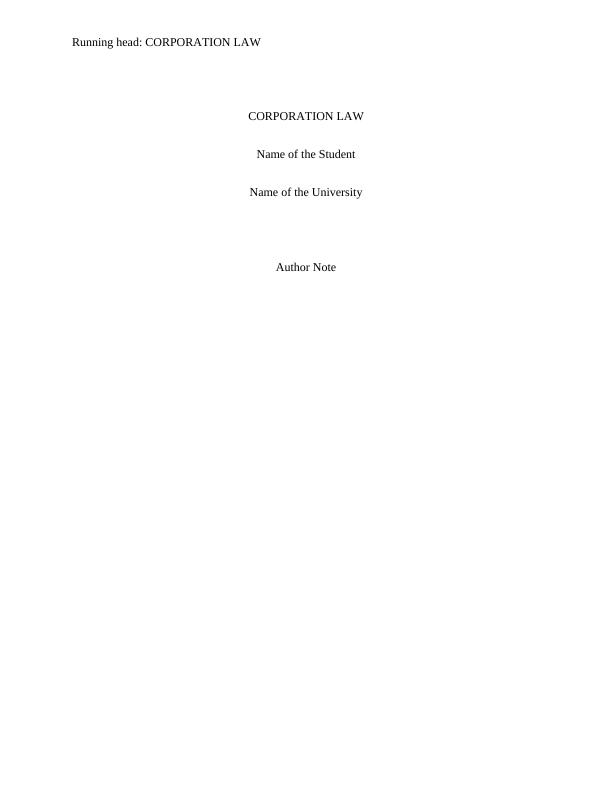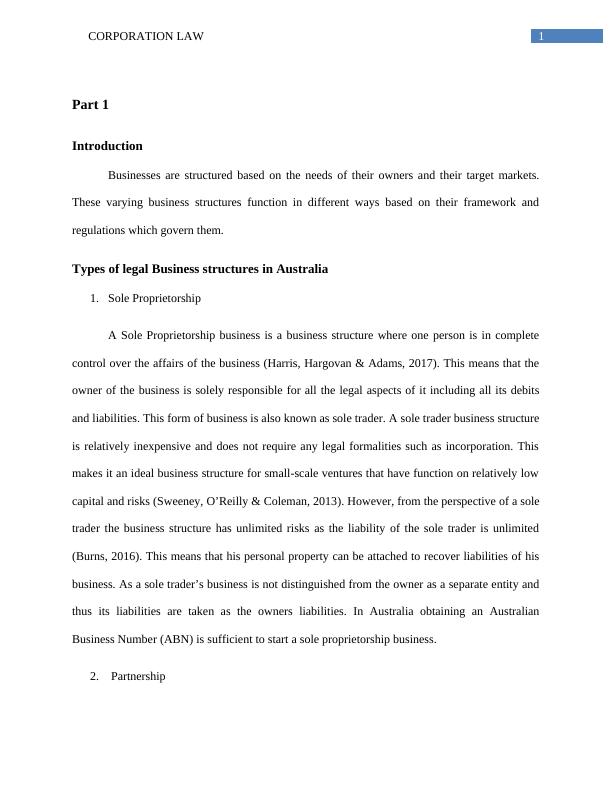Types of Legal Business Structures in Australia
Added on 2023-06-12
10 Pages2426 Words192 Views
Running head: CORPORATION LAW
CORPORATION LAW
Name of the Student
Name of the University
Author Note
CORPORATION LAW
Name of the Student
Name of the University
Author Note

1CORPORATION LAW
Part 1
Introduction
Businesses are structured based on the needs of their owners and their target markets.
These varying business structures function in different ways based on their framework and
regulations which govern them.
Types of legal Business structures in Australia
1. Sole Proprietorship
A Sole Proprietorship business is a business structure where one person is in complete
control over the affairs of the business (Harris, Hargovan & Adams, 2017). This means that the
owner of the business is solely responsible for all the legal aspects of it including all its debits
and liabilities. This form of business is also known as sole trader. A sole trader business structure
is relatively inexpensive and does not require any legal formalities such as incorporation. This
makes it an ideal business structure for small-scale ventures that have function on relatively low
capital and risks (Sweeney, O’Reilly & Coleman, 2013). However, from the perspective of a sole
trader the business structure has unlimited risks as the liability of the sole trader is unlimited
(Burns, 2016). This means that his personal property can be attached to recover liabilities of his
business. As a sole trader’s business is not distinguished from the owner as a separate entity and
thus its liabilities are taken as the owners liabilities. In Australia obtaining an Australian
Business Number (ABN) is sufficient to start a sole proprietorship business.
2. Partnership
Part 1
Introduction
Businesses are structured based on the needs of their owners and their target markets.
These varying business structures function in different ways based on their framework and
regulations which govern them.
Types of legal Business structures in Australia
1. Sole Proprietorship
A Sole Proprietorship business is a business structure where one person is in complete
control over the affairs of the business (Harris, Hargovan & Adams, 2017). This means that the
owner of the business is solely responsible for all the legal aspects of it including all its debits
and liabilities. This form of business is also known as sole trader. A sole trader business structure
is relatively inexpensive and does not require any legal formalities such as incorporation. This
makes it an ideal business structure for small-scale ventures that have function on relatively low
capital and risks (Sweeney, O’Reilly & Coleman, 2013). However, from the perspective of a sole
trader the business structure has unlimited risks as the liability of the sole trader is unlimited
(Burns, 2016). This means that his personal property can be attached to recover liabilities of his
business. As a sole trader’s business is not distinguished from the owner as a separate entity and
thus its liabilities are taken as the owners liabilities. In Australia obtaining an Australian
Business Number (ABN) is sufficient to start a sole proprietorship business.
2. Partnership

2CORPORATION LAW
A partnership is a business structure where various individuals agree to undertake
business activities jointly with the aim of earning and sharing profits. A partnership is formed
through mutual agreement and it is the mutuality of the transactions that forms the crux of this
business structure (Harris, Hargovan & Adams, 2017). The features of this form of business are
the joint ownership of the venture, sharing of profits and losses and concurrent rights that can be
mutually exercised. In the Australian legal system different states have enacted different
partnership legislations such as the Partnership Act, 1892 enacted in New South Wales or the
Partnership Act, 1891 which is in force in Queensland (Vermeesch & Lindgren, 2001).
Partnerships may have limited or unlimited liability depending on the framework of the
organization (Allen & Kraakman, 2016). In case of limited liability partnerships the liability of
the partners are restricted to the amount guaranteed by them at the time of formation of the
partnership.
3. Corporation
A corporation is the most common form of business structure for large-scale businesses
and is a separate legal entity on its own. This means that a corporation or company is responsible
for its own actions and can sue and be sued in its own name (Harris, Hargovan & Adams, 2017).
Thus a corporation is distinguished as a separate entity from its owners (shareholders). A
company is Australia is governed under by the Corporations Act, 2001 which defines and
regulates its functioning. Common law principles that have been developed through judgments
delivered over the years would also apply to corporations (Kraakman & Armour, 2017). A
company is incorporated by virtue of the capital raised from investors who become shareholders
once the investment is made. The corporate veil protects the administration of the company from
liability and this had also been reiterated in Salomon v A Salomon & Co Ltd [1896] UKHL 1
A partnership is a business structure where various individuals agree to undertake
business activities jointly with the aim of earning and sharing profits. A partnership is formed
through mutual agreement and it is the mutuality of the transactions that forms the crux of this
business structure (Harris, Hargovan & Adams, 2017). The features of this form of business are
the joint ownership of the venture, sharing of profits and losses and concurrent rights that can be
mutually exercised. In the Australian legal system different states have enacted different
partnership legislations such as the Partnership Act, 1892 enacted in New South Wales or the
Partnership Act, 1891 which is in force in Queensland (Vermeesch & Lindgren, 2001).
Partnerships may have limited or unlimited liability depending on the framework of the
organization (Allen & Kraakman, 2016). In case of limited liability partnerships the liability of
the partners are restricted to the amount guaranteed by them at the time of formation of the
partnership.
3. Corporation
A corporation is the most common form of business structure for large-scale businesses
and is a separate legal entity on its own. This means that a corporation or company is responsible
for its own actions and can sue and be sued in its own name (Harris, Hargovan & Adams, 2017).
Thus a corporation is distinguished as a separate entity from its owners (shareholders). A
company is Australia is governed under by the Corporations Act, 2001 which defines and
regulates its functioning. Common law principles that have been developed through judgments
delivered over the years would also apply to corporations (Kraakman & Armour, 2017). A
company is incorporated by virtue of the capital raised from investors who become shareholders
once the investment is made. The corporate veil protects the administration of the company from
liability and this had also been reiterated in Salomon v A Salomon & Co Ltd [1896] UKHL 1

End of preview
Want to access all the pages? Upload your documents or become a member.
Related Documents
Corporations and Business Structureslg...
|7
|2245
|59
Company law Assignment PDFlg...
|12
|2414
|19
Business Law : Question and Answerlg...
|9
|2161
|9
Legal Issues in Business Organizations, Tourism and Events Organizationslg...
|8
|2283
|118
Corporations and Business Structureslg...
|8
|2430
|49
Introduction to Business Law: Case Study on Business Structureslg...
|12
|3026
|191
